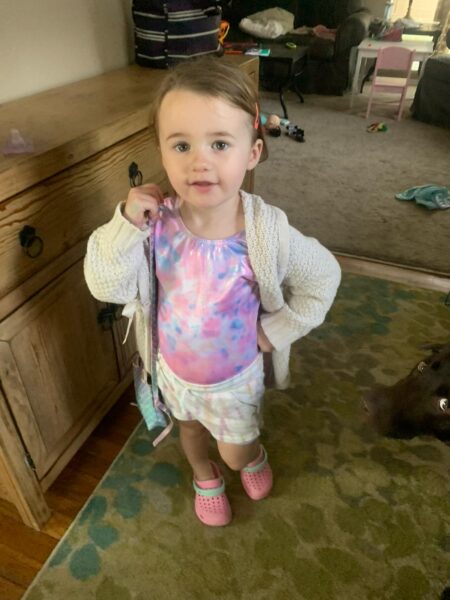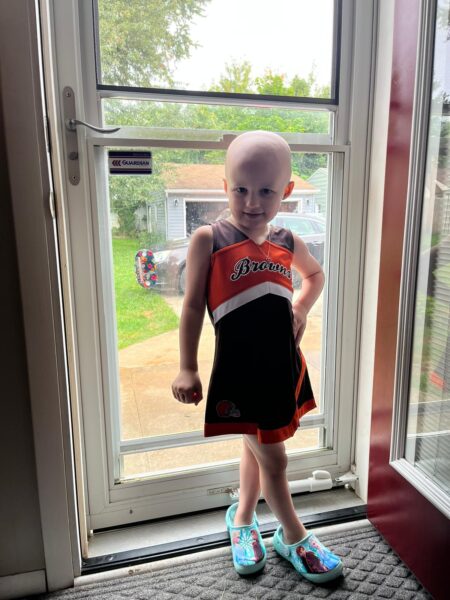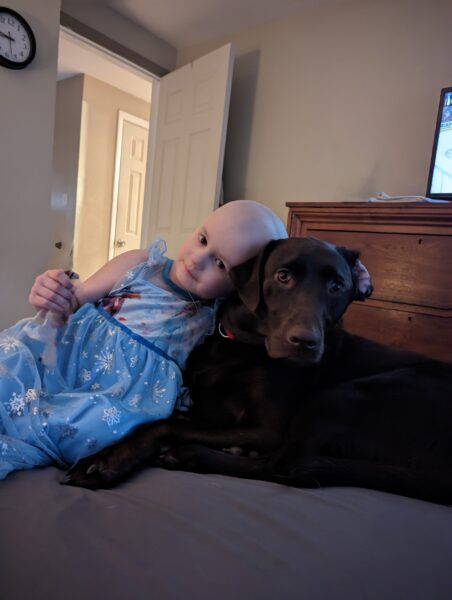
Prior to her neuroblastoma diagnosis, Dylan Harr was a healthy and active 3 year old who loved to do gymnastics.
Andrew and Brittney Harr still vividly remember the day in November 2022 they learned their 3-year-old daughter, Dylan, had cancer.
“Dylan was complaining that her back hurt and was limping and walking differently,” said Brittney. “I took her to the doctor a number of times, but they chalked it up to growing pains.”
Following her gut instinct that something else could be going on, Brittney took Dylan to the ER at Akron Children’s where they performed bloodwork followed by an abdominal CT.
“That’s when they told me they saw a mass in her abdomen,” said Brittney. “I couldn’t believe it. This was a child who had been doing gymnastics just a week earlier.”
Diagnosed with stage 4 neuroblastoma (a cancer that develops from immature nerve cells), Dylan was admitted to the hospital to begin chemotherapy to help shrink the tumor.
According to Dr. Megan Sampson, pediatric hematologist-oncologist and Dylan’s physician, treatment for neuroblastoma involves multiple modalities including chemotherapy, surgery, radiation and immunotherapy.
After 4 months of chemo, surgery was performed in March 2023 to remove the tumor with plans for a bone marrow transplant.

Dylan’s treatments for neuroblastoma have included chemotherapy, immunotherapy, surgery and a bone marrow transplant. She will also have to undergo radiation in 2024.
“Unfortunately, the response of her bony disease was not where we wanted it before transplant, so we had to do another round of chemo with immunotherapy added,” said Dr. Sampson.
With so much time spent as an inpatient, Dylan and her family became close to the doctors, nurses and child life specialists on the hematology/oncology floor.
“Dr. Sampson, Dr. Sarah Ferri (fellow) and Renee Redenshek (child life specialist) have all been incredible,” Brittney said. “They provide us with lots of resources and comfort.”
After wrapping up her chemo at the beginning of Sept., Dylan enjoyed a short break from treatment and took advantage by playing outside and spending time with her dog, Reba.
“She had a lot of energy which was nice to see,” said Andrew.
On Sept. 25, Dylan was back at Children’s to get prepped for the bone marrow transplant process.
“An autologous bone marrow transplant is when a patient receives high dose chemotherapy followed by an infusion of their own bone marrow stem cells,” said Dr. Sampson. “The dose of chemotherapy given would typically lead to the blood counts not recovering, but with the stem cell infusion, the blood counts recover in approximately 2 weeks.”
Dylan will remain an inpatient for approximately 30 days to watch closely for infections and complications. The process will then be repeated a second time. After the first of the year, Dylan will begin radiation followed by immunotherapy.

During a brief treatment break in September, Dylan experienced increased energy levels and enjoyed playing outside with her dog, Reba.
While the total treatment for neuroblastoma typically lasts approximately 1.5 years, Dr. Sampson said Dylan’s plan was adjusted due to her response to initial chemotherapy.
“Our goal is to further reduce disease before transplant,” said Dr. Sampson. “This added an additional 5 months of treatment but will hopefully improve the chances of cure long-term.”
Although she’s only 4 years old, Andrew says Dylan has some understanding of what’s happening to her.
“We liken her cancer treatment to fireworks in her belly,” he said. “We’re hoping all these treatments will blast the cancer right out her.”
While childhood cancer is rare, it is the leading cause of disease-related death past infancy in children and adolescents. If you’re looking for information about pediatric cancer care, Akron Children’s Showers Family Center for Childhood Cancer and Blood Disorders can help. Call 330-543-8580.










